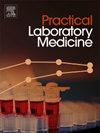全血细胞计数衍生的全身炎症生物标志物在疟疾感染中的诊断价值
IF 1.3
Q3 MEDICAL LABORATORY TECHNOLOGY
引用次数: 0
摘要
疟疾仍然是一个公共卫生问题。疟疾相关的炎症反应很容易由有益转为有害,因此早期发现疟疾炎症至关重要。全血细胞计数有望成为一种较便宜的检测方法,作为炎症的替代标志物。因此,本研究旨在确定fbc来源的全身炎症生物标志物在疟疾感染中的诊断价值。方法采用单点病例对照设计,纳入45例疟疾患者和50例健康人。我们收集了他们的人体测量学、社会人口学和临床信息。确定每个参与者的FBC估计和疟原虫计数。结果疟疾患者的所有全身炎症生物标志物(单核细胞与淋巴细胞比值(MLR)、中性粒细胞与淋巴细胞比值(NLR)、血小板与淋巴细胞比值(PLR)和全身炎症综合指数(AISI))均高于健康人群。寄生虫数量与NLR、MLR呈显著的中度相关(ρ = 0.5和0.4),与PLR和AISI呈弱负相关(ρ = - 0.2)。ROC曲线分析显示NLR (AUC = 0.937)具有良好的诊断和预测价值,敏感性为86.7%,特异性为92.0%。结论fbc衍生的炎症生物标志物NLR随着寄生虫数量的增加而增加。在2.12及以上的水平上,NLR识别疟疾患者炎症状态的敏感性为86.7%,特异性为92.0%。我们的研究结果表明,fbc衍生的系统性炎症生物标志物提供了一个解决方案,以满足对具有成本效益的替代炎症标志物的需求,特别是在资源匮乏地区。本文章由计算机程序翻译,如有差异,请以英文原文为准。

Diagnostic value of full blood count derived systemic inflammatory biomarkers in malaria infection
Background
Malaria remains a public health issue. Its associated inflammatory responses can easily shift from benefit to detriment, making early detection of malarial inflammation crucial. The full blood count promises to be a less expensive assay serving as a surrogate marker for inflammation. This study, therefore, aimed to determine the diagnostic value of FBC-derived systemic inflammatory biomarkers in malaria infection.
Method
We employ a single point case-control design that included 45 malaria patients and 50 healthy individuals. We collected their anthropometric, sociodemographic, and clinical information. FBC estimation and malaria parasite enumeration were determined for each participant.
Results
Malaria patients had higher values of all the systemic inflammatory biomarkers (monocyte-to-lymphocyte ratio (MLR), neutrophil-to-lymphocyte ratio (NLR), platelet-to-lymphocyte ratio (PLR), and aggregate index of systemic inflammation (AISI)) compared with healthy individuals. There was significant moderate correlation between parasite count and NLR, and MLR (ρ = 0.5 and ρ = 0.4) and a weak negative correlation with PLR and AISI (ρ = - 0.2 each). A receiver operator characteristic (ROC) curve analysis showed that NLR (AUC = 0.937) had an excellent diagnostic and predictive value, with sensitivity of 86.7 % and specificity of 92.0 %.
Conclusion
We have shown that the FBC-derived inflammatory biomarker— NLR— increases as parasite count increases. At a level of 2.12 and above, NLR is 86.7 % sensitive and 92.0 % specific in identifying the inflammatory state in malaria patients. Our findings show that the FBC-derived systemic inflammatory biomarkers provide a solution to the need for cost-effective surrogate inflammatory markers, especially in resource-deprived areas.
求助全文
通过发布文献求助,成功后即可免费获取论文全文。
去求助
来源期刊

Practical Laboratory Medicine
Health Professions-Radiological and Ultrasound Technology
CiteScore
3.50
自引率
0.00%
发文量
40
审稿时长
7 weeks
期刊介绍:
Practical Laboratory Medicine is a high-quality, peer-reviewed, international open-access journal publishing original research, new methods and critical evaluations, case reports and short papers in the fields of clinical chemistry and laboratory medicine. The objective of the journal is to provide practical information of immediate relevance to workers in clinical laboratories. The primary scope of the journal covers clinical chemistry, hematology, molecular biology and genetics relevant to laboratory medicine, microbiology, immunology, therapeutic drug monitoring and toxicology, laboratory management and informatics. We welcome papers which describe critical evaluations of biomarkers and their role in the diagnosis and treatment of clinically significant disease, validation of commercial and in-house IVD methods, method comparisons, interference reports, the development of new reagents and reference materials, reference range studies and regulatory compliance reports. Manuscripts describing the development of new methods applicable to laboratory medicine (including point-of-care testing) are particularly encouraged, even if preliminary or small scale.
 求助内容:
求助内容: 应助结果提醒方式:
应助结果提醒方式:


